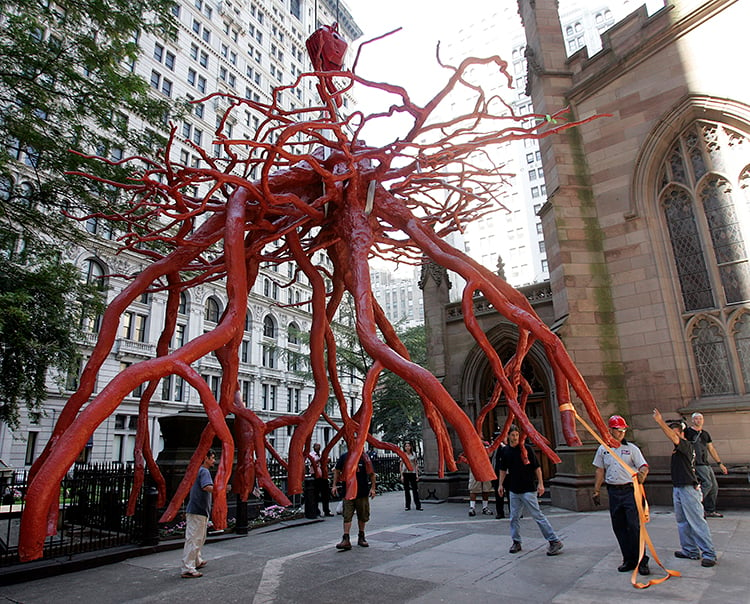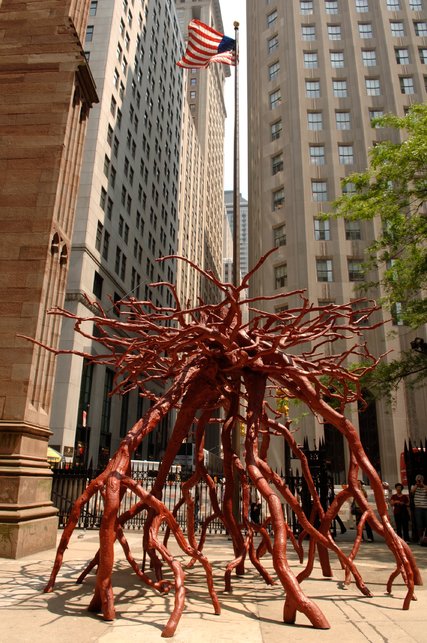Law & Politics
Artist Sues Trinity Church for $1.2 Million Over Clandestine Removal of 9/11 Memorial Sculpture
The church removed the three-ton work "under cover of night."

The church removed the three-ton work "under cover of night."

Brian Boucher

Today the Pennsylvania-based sculptor Steve Tobin filed a $1.2-million lawsuit against New York City’s Trinity Church Parish. The suit comes after a long dispute over the church’s removal of Tobin’s sculpture, Trinity Root, from its original site: the courtyard of St. Paul’s Chapel, which is also part of the parish. In 2005, Tobin donated the gargantuan tree-root sculpture to Trinity Church to memorialize the victims and survivors of 9/11. The lawsuit points out numerous instances where both parties to the contract characterized the sculpture as a permanent installation.
Tensions arose in 2015 when Kathleen Rogers, Tobin’s manager and communications consultant, contacted the church about restoring the sculpture’s patina, only to get an unnerving response. Trinity Church’s new rector, William Lupfer, admitted that he had already made plans to remove the sculpture on the grounds that it was “ugly.” Tobin countered, saying the sculpture’s meaning would be compromised if it were transferred to Tobin’s studio or to a Connecticut seminary, as the church proposed. Tobin also warned that it could be damaged unless properly transported.
While discussions were still underway, the church moved the sculpture overnight on December 11, 2016—”under cover of night,” as Tobin described it to artnet News. And as Tobin had cautioned, the sculpture was damaged, according to the suit. On a gloomy note, Tobin’s lawyer, Steven S. Honigman of New York, points out that since the sculpture was based precisely on the roots of the tree, there’s no guide to replacing the damaged parts since the original is no longer in existence.

Steve Tobin, Trinity Root. Courtesy of Steve Tobin.
Trinity Church mirrors the huge root structure of a 100-year-old sycamore tree that sheltered St. Paul’s Chapel from damage during the 9/11 attacks. Located across the street from the World Trade Center site, the chapel was minimally affected, though the tree toppled, revealing its roots. Dust from the attack, containing microscopic remains of some of the dead, was scattered throughout the churchyard. Tobin incorporated the remains into the sculpture’s patina. The three-ton sculpture measures some 20 feet long, and transporting it to the city necessitated closing the George Washington Bridge.
At the heart of Tobin’s claim is that the sculpture was meant to be permanent, but the church disagrees. In 2016, Trinity Church told artnet News that “We respect Mr. Tobin as an artist and his body of work. The original signed agreement between Trinity and Mr. Tobin never discussed a permanent installation.” The church went on to say that it needed more flexibility in its use of the churchyard.
The suit, covering breach of contract and violation of the artist’s rights under the Visual Artists Rights Act (VARA) of 1990, is meant to cover the amount Tobin says he and his studio spent on labor, materials, transportation, and other damages allowed by the law. His commitment to the project was such that he took out a home equity loan to meet the expenses, and said the piece was “the most important sculpture of my career.” And just as the work was specific to the site, the subject aligned precisely with Tobin’s signature imagery of tree roots.
“While we have no comment on this litigation, Trinity is pleased to have the sculpture at Trinity’s retreat center, where it will be among a collection of planned sites that will encourage prayerful reflection, remembrance, and spiritual transformation,” said church spokesman Nathan Brockman in an email.
VARA allows for damages if an artist’s work is defaced or destroyed, and if it is of “recognized stature.” Though there is not an extensive history of cases hinging on what constitutes “recognized stature,” one recent lawsuit does: a group of graffiti artists suing the owners of Long Island City’s 5Pointz building cite that the facade had served as a canvas for graffiti art. They go on to argue that the building the owners destroyed to make room for luxury condominiums, qualifies as art of “recognized stature.” Tobin’s lawyer has submitted extensive press coverage to bolster his argument that Trinity Root also makes the grade.
In David Philips v. Pembroke Real Estate, a VARA case in a jurisdiction in Massachusetts, David Philips v. Pembroke Real Estate, circuit judge Lipez held that the law does not apply to site-specific works. That decision isn’t binding precedent on the New York court, but will be influential.
Since 1993, Tobin has mounted solo exhibitions at venues ranging from The United States Botanic Garden in Washington DC to the Portland Museum of Art in Maine, among others. He’s also installed public artworks in cities like Calgary, Chicago, and New York.
Though he’s achieved considerable success as an artist, the suit puts him up against a behemoth of an institution. The venerable church has been in operation for more than three centuries. The lawsuit also points out that the church holds real estate valued at about $3.4 billion as of 2015.